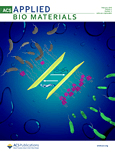
Materials Science & Engineering C-Materials for Biological Applications
Scope & Guideline
Empowering discoveries in materials for biological innovation.
Introduction
Aims and Scopes
- Biomaterials Development:
Research focused on developing new biomaterials that can interact positively with biological systems for applications in tissue engineering and regenerative medicine. - Drug Delivery Systems:
Innovative methods for delivering therapeutic agents using various nanocarriers, hydrogels, and other materials, aiming to enhance the efficacy and specificity of treatments. - Tissue Engineering:
Studies on scaffolding materials and techniques to support the growth and repair of tissues, including bone, cartilage, and soft tissues. - Biocompatibility and Bioactivity:
Investigation of the interactions between biomaterials and biological tissues, focusing on their safety, efficacy, and integration within the body. - Nanotechnology Applications:
Utilization of nanomaterials and nanostructures to improve material properties and functionalities for biomedical applications. - Surface Modification Techniques:
Research on enhancing the surface properties of materials to improve biocompatibility, drug delivery efficiency, and reduce bacterial adhesion.
Trending and Emerging
- Smart and Responsive Hydrogels:
There is a growing trend in the development of hydrogels that respond to environmental stimuli such as pH, temperature, and light, enhancing their functionality in drug delivery and tissue engineering. - 3D Bioprinting Technologies:
Research in 3D bioprinting is on the rise, focusing on creating complex tissue structures and scaffolds that mimic natural tissue architecture. - Targeted Nanoparticle Delivery Systems:
An increase in studies focusing on the design of nanoparticles that can specifically target tumor cells or tissues, improving therapeutic outcomes and reducing side effects. - Bioactive Coatings and Surface Modifications:
Emerging interest in the development of bioactive coatings for implants and scaffolds that enhance cell adhesion, proliferation, and overall integration. - Sustainable and Green Materials:
Research is increasingly oriented towards the use of sustainable materials and eco-friendly processes for developing biomaterials, reflecting a growing concern for environmental impacts. - Multifunctional Materials:
A trend towards developing materials that serve multiple functions, such as antibacterial properties combined with drug delivery capabilities, enhancing their applicability in biomedical fields.
Declining or Waning
- Traditional Polymer Biomaterials:
Research on conventional polymers for biomedical applications appears to be decreasing as more innovative materials and composites take center stage. - In vitro Testing Models:
Although still relevant, there seems to be a reduced emphasis on traditional in vitro testing in favor of more complex and predictive in vivo models or advanced in vitro systems. - Metallic Biomaterials:
The focus on traditional metallic materials, such as stainless steel and titanium, is waning in favor of more advanced materials that offer bioactivity and improved integration with biological systems. - Conventional Drug Delivery Methods:
Research on standard drug delivery methods is becoming less prevalent as the field moves towards more sophisticated systems that offer targeted and controlled release.
Similar Journals

Bioinspired Biomimetic and Nanobiomaterials
Fostering Interdisciplinary Insights in Biomimetic ResearchBioinspired Biomimetic and Nanobiomaterials is a distinguished journal published by Emerald Group Publishing Ltd, focusing on the cutting-edge intersection of biomaterials, engineering, and nanotechnology. Since its inception in 2012, the journal has provided a vital platform for researchers, professionals, and students to disseminate innovative findings that draw inspiration from nature to develop novel biomimetic and bioinspired materials. Although currently indexed in the fourth quartile for Biomaterials and third quartile for miscellaneous Engineering in 2023, the journal is committed to improving its standing and impact by welcoming contributions that exploit the functional capabilities of nanoscale and biomimetic structures. With a strategic aim to foster interdisciplinary collaboration, this journal plays an instrumental role in advancing the field of biomaterials and engineering. Join our community and contribute to shaping the future of sustainable material design and applications.

Accounts of Materials Research
Advancing the frontiers of materials science.Accounts of Materials Research is a premier journal published by the American Chemical Society, focusing on the multidimensional field of materials science. With a robust impact factor and a commitment to open-access research, it serves as a vital platform for leading-edge discoveries from 2020 to 2024. The journal has rapidly ascended to the top quartile in multiple categories, including Chemical Engineering, Materials Chemistry, and Polymers and Plastics, demonstrating its significant influence within the academic community. Recognized by Scopus as a key resource—with remarkable rankings that place it in the 95th percentile of its field—Accounts of Materials Research is devoted to publishing high-quality, innovative research that addresses critical challenges in materials development and implementation. This journal is essential for researchers, professionals, and students seeking to stay informed about the latest advancements and collaborative opportunities within the interdisciplinary landscape of materials science.

International Journal of Nanomedicine
Transforming research into revolutionary healthcare solutions.International Journal of Nanomedicine, published by DOVE MEDICAL PRESS LTD, is a leading open access journal dedicated to advancing the field of nanomedicine and its applications in healthcare. Since its establishment in 2006, the journal has grown significantly, now encompassing a wide array of topics including bioengineering, biomaterials, biophysics, drug discovery, and pharmaceutical sciences, and is recognized in Q1 quartiles across major categories like *Nanoscience and Nanotechnology* and *Organic Chemistry*. The journal boasts an impressive standing within the Scopus rankings, with high percentiles across various related fields, making it an invaluable resource for researchers, professionals, and students seeking to stay informed on the latest innovations and developments in nanomedicine. With its commitment to fostering an accessible and collaborative academic environment, the International Journal of Nanomedicine serves as a vital platform for disseminating transformative research that impacts scientific practice and healthcare outcomes globally.

Journal of Functional Biomaterials
Pioneering Discoveries in Biomedical InnovationJournal of Functional Biomaterials is a prominent peer-reviewed journal dedicated to the innovation and application of biomaterials, covering vital fields such as biomedical engineering and materials science. Published by MDPI in Switzerland, this Open Access journal has been serving the academic community since 2010, allowing unrestricted access to groundbreaking research. With an impressive Q2 ranking in both Biomaterials and Biomedical Engineering for 2023, it stands as a significant contributor to the fields it represents. Researchers will find the journal's focus on functional biomaterials particularly relevant, as it encompasses a diverse range of studies aimed at enhancing the performance and applicability of biomaterials in medical contexts. The journal's commitment to disseminating high-quality research fosters collaboration and innovation among professionals, making it an essential resource for anyone involved in this dynamic area of study.

Frontiers in Bioengineering and Biotechnology
Driving Breakthroughs in Biomedical Engineering and BeyondFrontiers in Bioengineering and Biotechnology, published by FRONTIERS MEDIA SA in Switzerland, stands as a leading platform for innovative research and developments in the fields of bioengineering and biotechnology. Since its inception in 2013, this Open Access journal has garnered significant recognition, reflected in its impressive category rankings: Q1 in Biomedical Engineering and Q2 in Bioengineering, Biotechnology, and Histology for 2023. With a focus on fostering collaboration and knowledge sharing, it aims to provide researchers, professionals, and students with access to pioneering studies that push the boundaries of science and technology. The journal, which is indexed in prominent databases, boasts high visibility and impact, evidenced by its impressive rankings across various categories in Scopus. As it continues to converge from 2013 to 2024, Frontiers in Bioengineering and Biotechnology is dedicated to shaping the discourse in its field and promoting advancements that have the potential to transform healthcare and environmental sustainability.

ACS Applied Bio Materials
Pioneering Research in Biomaterials for a Healthier TomorrowACS Applied Bio Materials is a leading academic journal published by the American Chemical Society, focusing on the innovative intersection of bioengineering and materials science. Since its inception in 2018, the journal has established itself as a pivotal platform for disseminating impactful research within the fields of Biochemistry, Biomaterials, Biomedical Engineering, and Chemistry, often ranked in the top tiers of these categories. With an impressive impact factor, it holds a Q2 ranking in both Biochemistry and Biomaterials, and a prestigious Q1 ranking in Biomedical Engineering and miscellaneous Chemistry, underscoring its significance in advancing knowledge and practices across these disciplines. The journal’s editorial commitment to high-quality, peer-reviewed research ensures relevance and rigor, appealing to a diverse audience of researchers, professionals, and students keen to explore breakthroughs in bio-related materials technology. The access options enhance its visibility and reach, allowing for a broader dissemination of studies that drive innovation and collaboration in biotechnology and material sciences. Located in the heart of Washington, DC, ACS Applied Bio Materials serves as a crucial resource for advancing the future of healthcare, engineering, and materials research.

BULLETIN OF MATERIALS SCIENCE
Exploring Innovations in Material MechanicsBulletin of Materials Science, published by the Indian Academy of Sciences, is a distinguished journal that has been contributing to the field of materials science since its inception in 1979. With an ISSN of 0250-4707 and E-ISSN 0973-7669, it provides a platform for researchers to share groundbreaking studies and advancements in the mechanics of materials and general materials science. As of 2023, the journal holds a respectable Q3 ranking in both the Materials Science (miscellaneous) and Mechanics of Materials categories, highlighting its competitive position in the academic landscape. Although the journal currently does not operate under an open access model, it remains a vital resource for professionals and students keen on exploring innovative material developments and methodologies. With a commitment to promoting high-quality research, the Bulletin of Materials Science features rigorous peer-review processes, making it an essential reference for anyone engaged in the materials science domain.

Gels
Unlocking the Potential of Gels Across DisciplinesGels is a distinguished, peer-reviewed journal published by MDPI, focusing on the innovative field of gels and their myriad applications across disciplines such as bioengineering, biomaterials, and organic chemistry. Since its inception in 2015, this Open Access journal has provided a platform for researchers to disseminate cutting-edge findings, enabling wider visibility and impact for their work. Based in Switzerland, Gels has firmly established itself within the academic community, achieving notable recognition as evidenced by its recent Q1 ranking in Polymers and Plastics, and multiple Q2 placements in related categories, demonstrating its relevance and importance in the field. The journal serves as a vital resource for professionals and scholars aiming to engage with the rapidly evolving research landscape surrounding gel technologies, making significant contributions to sustainable materials, drug delivery systems, and much more. With its commitment to Open Access, Gels ensures that research findings are readily accessible to all stakeholders, fostering collaboration and advancement in science and engineering fields.

Advanced Healthcare Materials
Bridging Science and Healthcare with Advanced MaterialsAdvanced Healthcare Materials, published by WILEY, is a leading journal in the interdisciplinary fields of biomaterials, biomedical engineering, and pharmaceutical science. With its ISSN 2192-2640 and E-ISSN 2192-2659, the journal provides a platform for innovative research that encompasses the design, fabrication, and application of advanced materials in healthcare settings. Recognized for its high impact, it boasts a Q1 ranking in several categories, including a notable rank of #7/183 in Pharmaceutical Science and 14/137 in Biomaterials according to Scopus rankings. This reflects the journal’s commitment to publishing cutting-edge studies that push the boundaries of science and technology in medicine. Although it operates under a subscription model, articles published in this journal significantly impact the global research community and play a crucial role in the advancement of healthcare technologies. With a publication history from 2012 to 2024, Advanced Healthcare Materials remains an essential resource for researchers, professionals, and students engaged in the groundbreaking intersections of materials science and healthcare.

ACS Biomaterials Science & Engineering
Fostering Innovation Through Rigorous Research and CollaborationACS Biomaterials Science & Engineering, published by the American Chemical Society, serves as a premier platform for the latest advancements and research in the fields of biomaterials and biomedical engineering. With an impressive impact factor and a strong reputation reflected in its ranking—Q2 in Biomaterials and Q1 in Biomedical Engineering—the journal attracts a diverse and engaged readership. Since its inception in 2015, it has aimed to foster innovation by publishing high-quality research articles, reviews, and perspectives on the synthesis, characterization, and application of biomaterials. Researchers and professionals benefit from the journal's rigorous peer-review process and its focus on translational science, making it essential for those looking to stay at the forefront of biomaterials research. Located in Washington, DC, USA, the journal plays a pivotal role in connecting academic and industrial sectors, ultimately driving advancements that impact biomedicine and related fields.